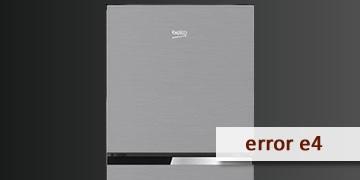Beko Refrigerator Error e4
Index of contents
What is the fault of error E4 Beko affecting your refrigerator?
A refrigerator or fridge at home is extremely important to keep our food in perfect condition. If you have a Beko brand refrigerator or fridge, you may at some point encounter the E4 error code on your essential appliance.
This error code indicates that there is a problem with the defrost heater, which is responsible for preventing ice buildup on the evaporator. It's a crucial component for the proper functioning of your refrigerator; otherwise, the fridge may exhibit abnormal operation and water leaks beneath it.
The defrost heater operates in cycles, meaning it turns on and off based on the temperature of the evaporator. If the defrosting time equals the maximum defrosting time of 60 minutes for 3 consecutive defrost cycles, then the E4 error code will be displayed on your refrigerator.
This error code can be caused by several factors, which we'll outline below, along with a brief explanation for each:
- The defrost heater is broken or damaged: If this device is damaged, it will prevent it from heating enough to melt the ice on the evaporator.
- The evaporator temperature sensor is dirty or damaged: This causes the refrigerator not to correctly detect the evaporator temperature and activate or deactivate the defrost heater when necessary.
- Loose, poorly connected, broken, burnt, or scorched wiring: This prevents the electrical signal from reaching correctly, leading to improper operation of the refrigerator.
- The PCB electronic board may be damaged or broken: This board controls everything the refrigerator does and doesn't do, so if it's damaged, it won't properly control the operation of the defrost heater and temperature sensor.
How to solve error E4 in Beko refrigerator?
To resolve the E4 error code in Beko refrigerators, you will need to follow the steps provided below. This way, you can attempt to fix this issue on your own:
- Restart the refrigerator: Disconnect the refrigerator from the power source for a few minutes and then reconnect it. Turn the refrigerator back on and check if the error has disappeared. This may clear the error code, allowing the refrigerator to return to normal operation, as this procedure resets all the sensors.
- Check the status of the defrost heater: You will need to remove the rear panel of the refrigerator and locate the heater, which is usually in the form of a resistance or a metal tube around the evaporator. Use a multimeter to measure the resistance of the heater and see if it falls within the range indicated by the manufacturer. If it is out of range or there is no continuity, it means it is defective and you will need to replace it.
- Check the status of the temperature sensor: Locate the temperature sensor, which is usually attached to or near the evaporator. Use a multimeter to measure the resistance of the sensor and check if it varies with the refrigerator's temperature. If it does not vary or is outside the range indicated by the manufacturer, it means it is defective and you will need to replace it with a new one.
- Perform preventive maintenance: It's also not a bad idea to perform preventive maintenance on your refrigerator. Use an electronic cleaner that you can find to clean the area around the evaporator, defrost heater, and temperature sensors.
- Check the condition of the wiring and connections: Inspect for any cut, burnt, scorched, loose, or disconnected cables between the heater, sensor, and the electronic PCB. If there is an issue, repair or replace the damaged cable or connection.
- Examine the status of the PCB electronic board: Locate the PCB board, usually behind the refrigerator's front panel or at the bottom. Check for any burnt components, swollen or damaged capacitors on the board. If there is a problem, you will need to replace it or desolder the damaged components and replace them. This requires advanced electronics knowledge.
- Repeat all the previous steps if the issue persists: If the problem continues, try repeating the aforementioned steps. Make sure to follow each step meticulously and leave nothing to chance. If, after performing all the checks and repairs mentioned earlier, the E4 error code still appears on your refrigerator, it indicates a more complex issue that requires a deeper inspection.
- Contact Beko technical support for assistance: If you cannot resolve the E4 error code on your own, it's best to seek help from experts in the field. Get in touch with Beko's technical service and request a visit from a qualified technician. We are confident that Beko's personnel will be able to diagnose and repair your refrigerator with the right tools and spare parts.
In summary and to conclude our article of tips and advice: The E4 error code in Beko refrigerators indicates a problem with the defrost heater. To address this issue, you should follow these steps:
- Restart the refrigerator
- Inspect and replace the defrost heater
- Inspect and replace the temperature sensor
- Perform preventive maintenance
- Check and repair the wiring and connections
- Inspect and replace the electronic board
- Repeat the previous steps if the problem persists
- Contact Beko technical support
